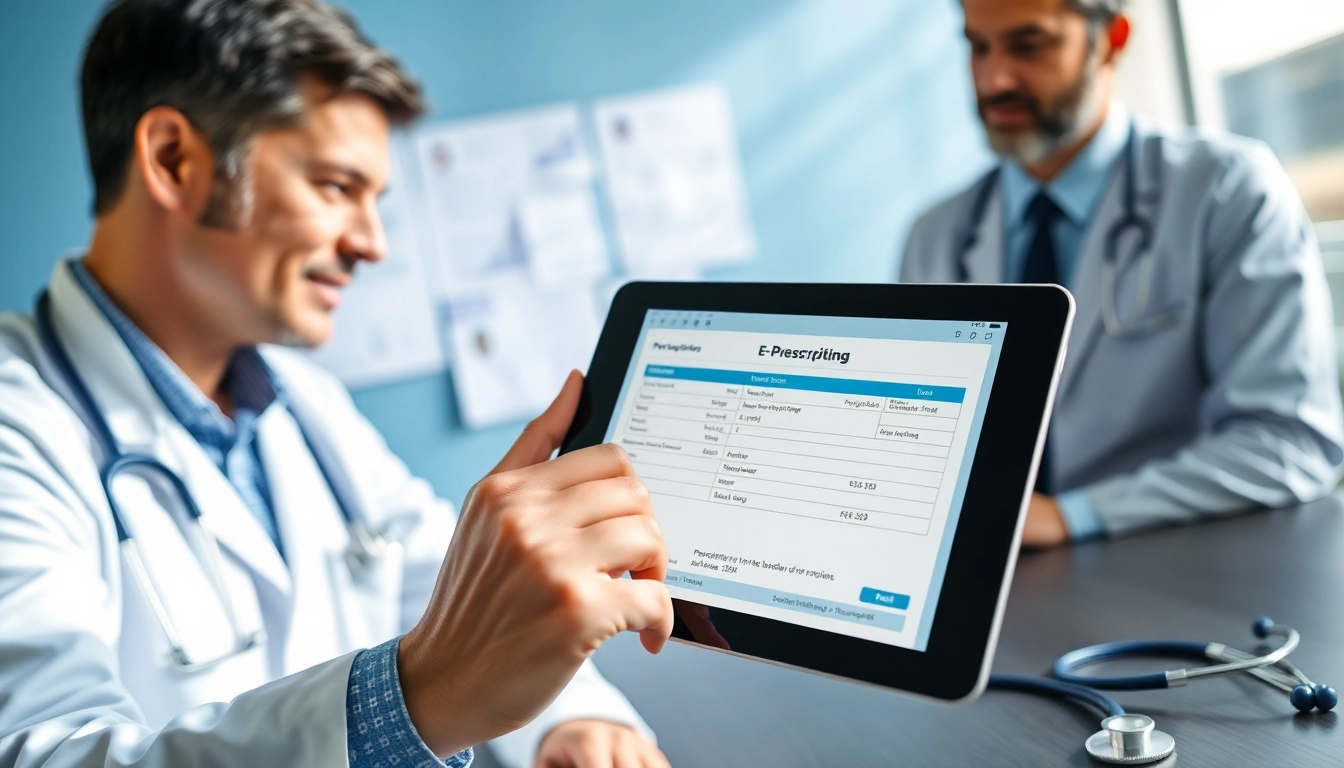Understanding Eprescribing Software for Small Practices
In the evolving landscape of healthcare, ePrescribing software stands out as a critical tool for medical practices, particularly those on a smaller scale. By integrating this technology, practices can streamline their prescription processes, enhance patient safety, and ultimately improve the overall quality of care. As we delve into the specifics of eprescribing software for small practices, let’s explore what it entails and how it can be a game-changer for healthcare providers.
What is Eprescribing?
Eprescribing, or electronic prescribing, is the process of electronically generating and sending prescription orders to pharmacies. This system replaces traditional paper prescriptions, which can be prone to errors, delays, and complications in patient care. Eprescribing enables healthcare providers to electronically check a patient’s medication history, manage refills, and even monitor potential drug interactions in real time. This not only increases the efficiency of the prescribing process but also enhances patient safety and satisfaction by reducing misunderstandings that often accompany handwritten scripts.
Key Features to Look For
When selecting ePrescribing software, several key features should be prioritized:
- User-Friendly Interface: The software should have an intuitive design that simplifies the prescribing process for healthcare providers.
- Database Integration: Look for systems that integrate with existing Electronic Health Record (EHR) systems for seamless data transfer.
- Medication History Access: Comprehensive access to a patient’s prior medication history helps to avoid dangerous drug interactions and improves continuity of care.
- Controlled Substances Management: Support for prescribing controlled substances electronically is crucial in ensuring compliance with regulatory requirements and enhancing patient safety.
- Security Measures: Assure that the software is HIPAA-compliant and includes features like data encryption and access controls to protect patient information.
- Prescription Tracking: Features that allow tracking of prescriptions from creation to completion help manage patient adherence and reduce errors.
Benefits of Implementing Eprescribing
Implementing ePrescribing software within small practices can yield significant benefits:
- Increased Efficiency: Automating the prescription process saves time for both practitioners and patients, allowing for quicker patient visits and reduced wait times.
- Improved Accuracy: Electronic prescriptions reduce the risk of misinterpretation that often occurs with handwritten scripts, thus promoting safer medication management.
- Enhanced Patient Safety: Real-time checks against drug interactions and allergies help prevent adverse drug events, improving patient outcomes.
- Cost-Effectiveness: Although there may be initial setup costs, the long-term savings resulting from reduced prescription errors can offset these expenses.
- Better Patient Engagement: Many ePrescribing systems allow patients to manage their prescriptions via mobile apps, fostering engagement and adherence to treatment plans.
- Streamlined Communication: Facilitating better communication between providers and pharmacies helps ensure that patients receive their medications in a timely manner.
Choosing the Right Eprescribing Software
Selecting the right ePrescribing software is essential for its successful implementation. Below, we outline key factors to consider when making your choice.
Assessing Your Practice Needs
Begin by evaluating the specific needs of your practice. Consider the following factors:
- Practice Size: Different software solutions may cater to practices of varying sizes. Assess whether the software can adapt to your current scale and future growth.
- Specialty Requirements: Certain medical specialties have unique prescribing needs; ensure the software aligns with your practice’s specific domain.
- User Volume: Consider how many users will access the system and whether it can accommodate growth or seasonal fluctuations in patient load.
- Budget Constraints: Establish a clear budget for software expenditures and evaluate pricing structures of available options, including subscription plans and potential hidden costs.
- Integration with Current Systems: Assess how well prospective software integrates with existing EHR systems or other practice management tools.
Comparative Features and Pricing
Explore the features of multiple ePrescribing solutions and develop a comparative analysis based on the following criteria:
- Core Features: Create a checklist of must-have features and compare how each software measures up against this list.
- Cost Transparency: Look for clarity in pricing models, ensuring that you understand recurring fees for maintenance, upgrades, and customer support.
- User Reviews: Gather feedback from current users regarding their experiences with the software, focusing on ease of use and reliability.
Trial Periods and Demos
Before finalizing your decision, take advantage of trial periods and demos offered by software vendors. This phase can provide insight into:
- User Experience: Engage with the software to identify its usability and suitability for your team’s workflow.
- Technical Support: Evaluate the responsiveness and helpfulness of customer support during the trial period to gauge their commitment to service.
- Customization Options: Determine whether the software can be tailored to suit your unique prescribing habits and practice policies.
Integrating Eprescribing into Daily Practice
Successfully integrating ePrescribing into your practice requires careful planning and execution. Here are strategies to facilitate this transition.
Training Staff for Effective Use
Effective training is essential for ensuring that all staff members are comfortable using the new software. Consider implementing the following training strategies:
- Comprehensive Workshops: Organize workshops that cover all aspects of the software, from basic functionality to advanced features.
- Hands-On Practice: Provide opportunities for staff to practice using the software in a controlled environment before going live.
- Continuous Learning: Offer ongoing education resources, such as online tutorials or refresher courses, to keep staff updated on system upgrades or new features.
Creating Patient Workflows
Efficient workflows can significantly enhance patient care and staff productivity. To establish effective workflows, consider the following:
- Standardization: Develop standardized protocols for prescribing, including essential checks and balances.
- Streamlining Communication: Ensure that the software facilitates clear communication between providers, pharmacies, and patients.
- Patient Engagement Tools: Utilize the software’s capabilities to keep patients informed about their prescriptions via notifications or mobile access.
Common Challenges and Solutions
The transition to ePrescribing may encounter challenges. Here are some common issues along with potential solutions:
- Resistance to Change: Some staff may be reluctant to adopt new technology. Solution: Frame the new system as a tool to make their jobs easier and enhance patient care.
- Technical Difficulties: Early technical issues can disrupt workflows. Solution: Ensure robust technical support is available during the initial roll-out phase.
- Patient Pushback: Patients may be unfamiliar with the ePrescribing process. Solution: Educate patients about the benefits of ePrescribing and how it enhances their experience.
Compliance and Security in Eprescribing
Compliance and security are non-negotiable aspects of ePrescribing. Adhering to regulations and ensuring data security is vital for safeguarding both patient information and the integrity of your practice.
Understanding HIPAA Regulations
The Health Insurance Portability and Accountability Act (HIPAA) establishes strict regulations for protecting patient information. In the context of ePrescribing, ensure your software:
- Encrypts Data: All patient data should be encrypted during transmission and storage to prevent unauthorized access.
- Implements Access Controls: Only authorized personnel should be able to access the software, with robust authentication measures in place.
- Maintains Documentation: Keep comprehensive records of user activity and data access to ensure transparency and accountability.
Security Features to Ensure Data Safety
Beyond compliance with HIPAA, your ePrescribing software should include several security features to ensure data safety:
- Regular Updates: The software must receive regular updates to address emerging security threats.
- Audit Trails: The ability to track changes and access logs ensures accountability and helps in identifying potential breaches.
- Backup Solutions: Strong data backup protocols are crucial to prevent data loss in case of hardware failures or cyber incidents.
Audit Trails and Record Keeping
Maintaining thorough records through audit trails is essential in ePrescribing. This practice helps in:
- Identifying Errors: Audit trails allow for quick identification of errors and issues within the prescription process.
- Ensuring Accountability: Tracking who accessed or altered records fosters a culture of responsibility among staff.
- Support for Compliance Checks: Detailed records aid in ensuring compliance during audits and reviews by regulatory bodies.
Evaluating the Effectiveness of Eprescribing Software
Once implemented, gauging the effectiveness of your ePrescribing software is essential for continuous improvement. Conduct regular evaluations based on key performance indicators (KPIs) and feedback.
Key Performance Indicators (KPIs)
Identifying relevant KPIs will help track the software’s impact on your practice. Consider these metrics:
- Prescription Error Rates: Monitor the frequency of medication errors to determine the software’s impact on accuracy.
- Patient Wait Times: Assess how ePrescribing affects patient wait times for prescriptions, indicating operational efficiency.
- Provider Utilization Rates: Examine how frequently healthcare providers use the software, suggesting its effectiveness and acceptance.
Collecting and Analyzing Feedback
Gathering feedback from both staff and patients is crucial in understanding the software’s effectiveness. Strategies include:
- Surveys: Conduct regular surveys to gather insights on user satisfaction and areas for improvement.
- Focus Groups: Assemble small groups of users to discuss experiences, challenges, and suggestions.
- Patient Care Outcomes: Analyze how ePrescribing has affected patient care outcomes, such as adherence and satisfaction.
Continuous Improvement Practices
Implementing a culture of continuous improvement will ensure that your ePrescribing system remains effective. Consider these practices:
- Regular Training Updates: Implement ongoing training sessions to address any new features or updates to the software.
- Performance Reviews: Schedule periodic performance reviews of the software to assess its effectiveness and identify potential upgrades.
- Engagement with Vendors: Maintain an open line of communication with your software vendor to ensure you are informed of new capabilities and best practices.



